A few weeks ago, I gently shut the door on my kids, husband and research work, and went for a walk. The walk lasted 7 days and cut across the neighboring mountains, which, lucky for me, happen to be the Swiss Alps.
The journey was a long time coming, a project born of less than noble seeds. After having my second child, I floated the idea of a Fat Camp to my husband. Skeptical, he asked what it consisted of, and what it cost. When I told him it was something like $2000 a week to hike a lot and eat little, he made a face and said: ” Why don’t you just go hiking in the mountains for a couple of weeks, with, like, no cash and a bunch of nuts in your bag?” The man had a point. And so every year since I toyed with the idea, but it was never the right time. Every summer, something came up, a move, a wait for a visa, a baby, work.
This year was the year. In spite of the pandemic, I saw one week where the logistics fit. Nothing terribly demanding at work, all kids at camp or daycare, nice weather. I hesitated, for the usual non-logistical reasons, namely guilt, and fear and also sadness. I like my family and experiencing something without them is always bittersweet. Two days beforehand though, I started booking places. I’d been planning my route for years and wanted to follow a section of the Via Alpina. All I needed to do was to find places to sleep in along the way. The plan was to do sections 14 to 20 of the route, starting in the Bernese Oberland and ending in nearby Montreux.
Day 1
The first day was taken by sending my eldest off to Scout camp, where he too would be hiking in the mountains. Afterwards, I quickly printed off my route and hotel information, downloaded a few apps (MyTrails, and SwissMobil) and rushed to the bookstore to buy 2 topographical maps, one of the Berner Oberland and the other of the Pays d’Enhaut.
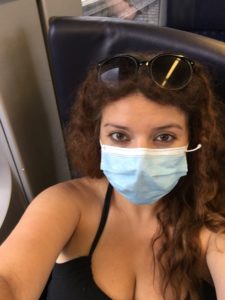
I packed my trusty Deueter quickly, the complexity of travel drastically reduced by being kid-free. Packed light too, another hard-won lesson courtesy of motherhood. That afternoon, I took the train to Kandersteg, first stop on the way. The charm and majesty of the Bernese Oberland is difficult to overstate. Within a few minutes of setting off from the town’s train station, I crossed paths with a lady in a miniature horse-drawn carriage, seated next to a dog.
That night, I stayed at a family run B&B, the Hotel des Alpes, where loneliness killed my appetite. I took out my maps, books and printouts and realized that…my plan was insane. Seven hour hikes alone over mountain passes when my last serious hike was a decade ago seemed ridiculous. What if I fell? I would be that foolish woman in the 20 minutes -a mother no less!- who studies decision-making under risk! – in need of a mountain rescue.
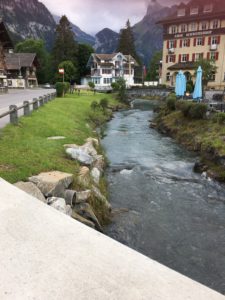
As a child, my family did not hike or camp. At this moment, I can conjure up my mother’s gentle laughter at the mere suggestion. But growing up in a city, I always craved the outside. Then at 15, I went hiking for the first time. On a school trip. For several days. It was my first time away from my parents. And, oh, it was in the Kathmandu Valley. Yes. Why do stuff halfway, ever? In Nepal, I camped and hiked for the first time and loved it. I’ve hiked in many other places since (though I’ve yet to fulfill my teenage promise of going back to Nepal for a longer trip) but Switzerland remains a standout, not just for the beauty of the trails, but how well they’re maintained and marked, how easy and safe it is to get around. Still, on Day 1, I realized I had perhaps been a tad breezy about it all. So I scrapped my initial plans and decided to craft my own trajectory through to Montreux, following the Via Alpina’s approximate path, but, you know, cheating here and there.
Switzerland: Where there’s a hill, there’s a way.
Day 2 – Kandersteg to Adelboden
A quick note on the Hotel des Alpes – it’s a great family place with a play area inside and outside. Mental dog-eared that one. After breakfast, I set out to find the gondola that would take me up to Allmenalp. I may have been the only hiker heading up, with those in line with me carrying either rock-climbing or parasailing gear. Once at the top, I set out west towards the Bundergrad at some 2400 meters in altitude (the Via Alpina way would have you go over the Bunderspitz – a flank I wanted to avoid because of the scree). The trail and ascent were fine and looking behind me, I could see a glorious alpine lake, the Oeschinensee. But at some point I hit ambiguity, marked by a cairn. On my left was a gully, and further up, the mountain trail marking. I thought I must have lost my way and started descending the steep slope. Where was I meant to cross? I picked my way carefully with my new walking sticks. (For all of a couple of minutes. Those things come highly recommended but I found them distracting and cumbersome: I put them away and did not used them again for the rest of the trip.) After coming down a few meters, I turned back up, realizing the cairn marked the crossing point of the gully. Relieved, I clambered down and through the ravine, up towards a second cairn on the opposite side. From there, a steep climb to the summit, steeped in fear. The peak disappeared in and out of the clouds, until I too was in the cloud.
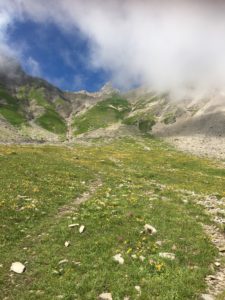
I berated myself for being chicken, but also for being on a hike. Were my motives pure? Did I belong up here? Was I doing this just to prove myself to a society that was skeptical of me? Me, older, heavier, exotic, mother. There is a trap there, when you tick those boxes, that you will go through life upping the ante, not out of joy, that childhood joy of mastery, but out of fear, buying insurance against those who will tell you in a thousand ways: you don’t belong. Those faces and words played out in a reel in my mind, judging me on my breath, my steps, my speed.
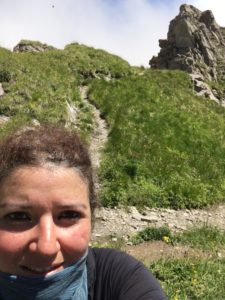
Because, what the hell was I doing in a cloud? Fog was my fear, driving on highway 1, or in the Gros-de-Vaud. It wasn’t even a fear I wanted to overcome. I considered my motives again and again and settled on their purity. I liked hiking and always have, well before I encountered judgement and exclusion. The fact is I was a busy, high-achiever in need of a break. I needed the exercise and prefer being outdoors. I was not doing this to gain a badge for others, but quitting would have certainly been a tribute of defeat, an acknowledgment of the wrong’s supremacy.With the summit came reason, and then joy, elation that I was there, totally fine, and that the following days were going to be awesome. At the top, I sat off to the side of the trail, listening to my breath, my heartbeat slowing, and in their place, reader, was not silence or howling wind, but a near deafening buzz of the bees I sat among, kind enough to share their alpine meadow with my rear.
Day 3- Adelboden-Lenk
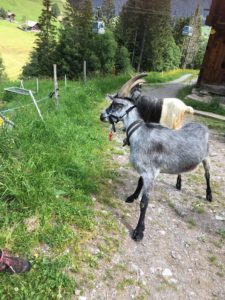
In Adelboden, I stayed at the Hotel Baren. Nice, clean, warm. I washed my clothes, went out for dinner (cold quiche at a bakery) and planned my route for the next day. I decided I would follow the Via Alpina proper in the next stage. Leaving Adelboden, I headed towards the Hahnenmoos Pass, at about 2000 m. Outside town, I crossed paths with a group of children, led by a lady and her snazzily accessorized goats. (Yes!). As I ascended, whole families came careening down laughing on giant scooters. Another dog-ear for family fun. Nearing the top of the mountain, I heard first, then saw a fleet of model planes circling the sky like buzzards. Apparently, Hahnenmoos is a great place to fly model planes. Unlike the previous day, the summit here was thoroughly civilized, with a signal, a restaurant and a playground. (Pro tip for quick and easy power lunch: coffee and a slice of Eingadiner tart.)
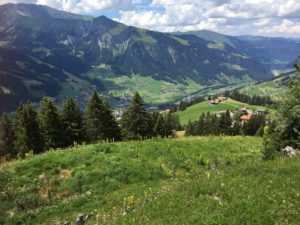
Picturesque mountain areas in Switzerland abound, but it’s the Bernese Oberland especially that leaves me in awe. A few years ago, I heard a mysterious story of writings attributed to a figure dubbed the Friend of God from the Oberland, from the 14th century. I know little of Protestant theological writings, but the name alone struck me. The beauty of the Oberland lends itself well to closeness with the Divine. The natural landscape is breath-taking and could easily be heard as a call from the Majestic. Moving through the mountains was a conversation with a primal power. There’s an understanding that though we may conquer summits, the mountains can turn on you anytime, and a healthy respect was due. It is the same with the ocean, these reminders on earth of how puny we are. Who needs a church, or a deacon, in such a place? One day perhaps I may read what the Friend of God of the Oberland had to say, but I dread the disappointment. I would rather sympathize with his moniker alone, which reveals so much more than whatever his given name could have been.
Day 4- Lenk-Gstaad
I spent the night at the Mountain Lodge in Lenk and woke up with some trepidation. A pain in my toe had not abated overnight but gotten worse. So I scrapped yet another Via Alpina stage, and rerouted my next segment. I took the cable car to Leiterli from Lenk, and walked up a little ways to the summit. A busy trail with lots of families. From the summit, the trail runs along a ridge.
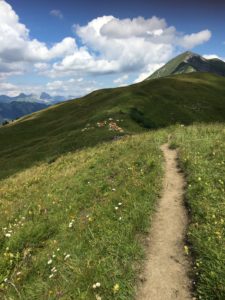
There, I ran into cows. Blocking the path, on a ridge. I’d heard, over the years in Switzerland, that cow-related injuries are common with ignorant hikers. I wasn’t sure what to do so I asked an older couple who came up behind me. They laughed and invited me to walk between them.
They may have laughed but they still carefully circumvented each offending cow.
Past the ridge, the crowd fell away, and I was blissfully alone again. I walked down to Lauenen, where I’d been advised to take the bus to Gstaad, and felt a bit cheated. I could have gone up Leiterli on foot. So I walked on to Gstaad instead, an easy beautiful walk along a river, the Louibach. Arriving to Gstaad, tired and sweaty amidst the glitz and gilt, was the type of moment I live for. Survival often demands conformity, but I crave the oddballs, be they events, people, places, you name it. And I was the oddball (honestly, not too much so) then and there. Along the main drag, I treated myself to an ice cream (CHF 4; even in the middle of Gstaad, there’s something for shallow pockets), a bit wistful about leaving Canton Bern.
As I said before, I love the Bernese Oberland, and have since I was little. A family holiday here remained etched in my heart, a venture outside of Geneva, a city we visited often enough in transit. I fell hard for the region then, at 7 or 8 years of age. I remember the awe I felt, not just at the mountains surrounding me, but the sheer luxury and the privilege of security.
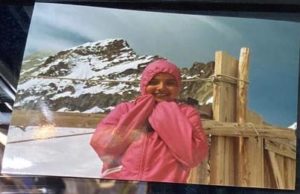
I saw children my age walking on their own, doing their kid thing, unaccompanied by adults. It was a sight I’d never seen in the DC metro area, where I lived. I loved the area so much that I ended up picking German to study years later, because the sound of the language was paired in my mind to a magical time. Never did I think I would end up living so close, that my own kids would have a luxury I didn’t have, to be kids, to walk outside, free.
Day 5 – Saanen-Chateau d’Oex
The Via Alpina stage here was supposed to be Gstaad-Etivaz, over the Gummifluh. But there was no accommodation in Etivaz, so I had booked a stay in nearby Chateau d’Oex. Here’s a testimony to how a city mouse like me can become provincial: I was so excited to cross back into Canton Vaud! At the hostel in Saanen (a short bus ride from Gstaad) I had taken out my maps again, knowing that hiking over the Gummifluh was not going to happen with the weather or my blistered feet.
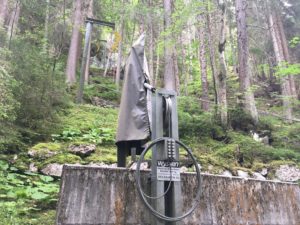
But neither did I want to walk along the river, as nice as it was. So I opted to head west a way before turning south and gaining some altitude at Les Planards. Despite the pain, it was a beautiful walk. There was some rain and storm clouds threatened but they gave me a day in solitude. Cerebral quietude had been achieved, replaced by the simple task of setting one foot in front of the other. Walking towards Chateau d’Oex, I crossed a waterfall, and then a crazy footbridge. Chateau d’Oex was a welcome sight, another beautiful little town.
Switzerland: The Whole Country’s a Postcard
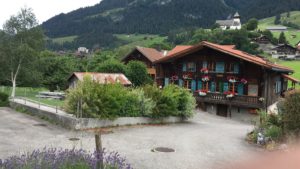
It’s amazing that, even quasi-disembodied for all these years, I could still rely on my feet and legs to carry me so well, and my eyes to identify the trail, the steps of some other human who passed before me. We are so well-equipped that even disuse does not stamp out these faculties, nor does city dwelling abolish our deep pact with nature. But the thought did cross my mind that being “outdoorsy” may not be such an obvious sign of love for nature. Doubt crept in again. For, what was I doing there, in the woods, on a mountain top, etc? Intruding. I didn’t truly belong here, crashing through the woods, in the meadows, snapping twigs beneath my feet. Do we not disrupt nature, even if we tread softly and travel light? Are we not interlopers, bringing in all kinds of smells and noise to places that we need not have dominion over? There is an arrogance in outdoor pursuits just like there is for other forms of travel: the cost of “equipment” alone presents a barrier to entry, signals for a certain tribe. Also, one can only appreciate the outdoors when an indoors is readily available. These were echoes of thoughts I had when backpacking in Asia years ago, born of guilt at my relative wealth, the disquieting thought that the nobility of the traveler may be misplaced. But in the end, there’s a pact, a homecoming in being outside, in negotiating with the elements and that is the basis of the imperative behind the right to be free to roam. Only, it must be extended to all, not just the male or the wealthy. All must be free to roam.
Day 6 Chateau d’Oex- Rossinière
The day’s excursion was not going to be difficult, barely a hike. I stayed at my hotel (Roc et Neige), and took advantage of their sauna, heading out only in the late morning. But the weather was iffy, so I didn’t add a detour. The way from Chateau d’Oex to Rossinière was short and easy. I did cross paths with another lone woman, not the first of the week. It was remarkable that, at no point over the week did I fear for my personal safety.
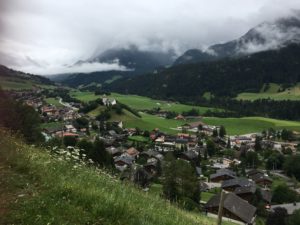
It was that same privilege and luxury I felt here as a child, a treasure you cannot find in most countries.
Switzerland: Still Sane, still Humane.
Arriving to Rossinière was a tad anti-climactic, a walk I might have done with my kids. I stayed at a B&B, the Chalet la Colline, which was a proper chalet. I’d actually never been in one before and this one fit the image inside and out to a T. Everything about this place was adorable and warm, including the
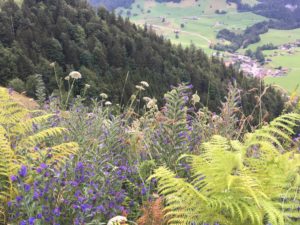
hosts. With time to spare, I allowed myself something I never do: a few hours of idleness. A bath in a claw foot tub. Disrupted only by my daily map consultations. It was in Rossinière that I downloaded a pretty cool app: OS locate. Because, no, I did not bring a compass. In the evening, I wondered down to the village and had a rather mediocre meal at City Hall. The blisters on my feet were now fire but I decided I would simply walk on, just as our ancestors probably did.
I work on pain these days, an area I was previously somewhat ignorant of and purposely so, as I avoid studying unpleasant topics. But being immersed in the subject leads me to probe its niches to find personal meaning. It’s reasonable to argue that, with time and age, one gets pretty good at avoiding unnecessary physical pain. You learn to pick the right shoes and mattress. Emotional pain, on the other hand, I view as a necessary by-product of the human condition. It certainly comes along with motherhood. But my distance from physical pain left me feeling a bit fraudulent, not just as a scientist, but as a person. Because pain is a quick way to consciousness. Pain is a common example of qualia. One minor goal on my trip was getting reacquainted with, let’s say, a wholesome physical pain, to remind myself of my own consciousness.
A big topic in neuroscience is the notion of the embodied self, the idea that the self is tethered to the body, and therefore the body (not just the brain) is a means of probing the self. It harkens back to Spinoza, and dual-aspect monism, the notion that the body and the mind are two sides of the same coin. Of course the brain is part of the body, and neuroscience relies, at least to some degree, on the idea that the self, that consciousness lives there. But the embodied self hypothesis, and its extension, embodied cognition, are ideas that leave me skeptical. Specifically, I think they are male-centered.
Is the body to a woman the same as it is to a man? The seeds of that skepticism come from biological motherhood, where a disembodiment, a distancing between the sense of self and its physical vehicle, is part of the process of human creation. Someone else lays claim to the mother’s body, even after cleaving from it. In my experience, over a decade, my body expanded and shrunk several times, blurring the roadmap between my self and it, leading to missteps and clumsiness. Beyond motherhood, there are all the other ways female bodies betray the female self: a try at hormonal birth control may lead to a statement like “I am not myself” but these women go on living, with a self leading them, nonetheless. Then there is of course the disembodiment – and dispossession – that comes from the male gaze – but this also does not necessarily lead to a loss of self. Finally, modern life, and more recently, confinement, have shown us that we may not need our bodies much at all. Our work is no longer physical, and our bodily presence is may be more of a tradition rather than a necessity.
But physical pain is (one) sure-fire way of connecting the body to the self. And so by imposing one of its functions (perambulating), I sought out pain, as a coming home to my own body. Except I was hoping for muscle soreness (a pleasing pain, signalling a good bout of exercise), not an utterly stupid, quasi-debilitating blister.
Day 7 – Rossinière – Haut-de-Caux
Morning in Rossinière, breakfast with my lovely hosts and a recommendation on my day’s journey, given the weather. The Via Alpina stage here should have been Rossinière to Rochers de Naye, but the clouds clung low to the flanks of the mountain. I decided on a train to Allières, followed by a hike to the Dent de Jaman. In Allières, some old man told me off for walking in the wrong direction off the platform. The place was barely a village. I started walking south and fell back into the rhythm I had come to cherish the past few days, a falling away of the noise,
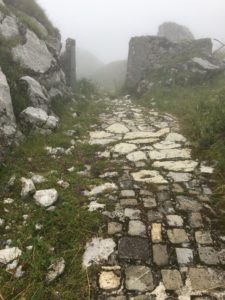
a path of quiet joy as I walked on. I was quick to meet with fog, my dread. I could see perhaps 50 feet ahead, doable on an easy path. But after an hour or so of walking, I encountered cows on the path again. One lifted her head and glared at me, challenging. Ooookay. I had a Karen moment, where I thought, who the hell owns these cows and why can’t they come and deal with them?
I stayed put for a few minutes, waiting for the cow to move along. And she eventually did, downright sashayed as she picked her way deliberately a few feet up the slope. Walking in the cloud, everything was covered in fine crystals of water. Along the way on the pass, there were ruins of a stone house or chapel. I wandered through them, wondering what and why, but relieved that even in such a haunting setting, warmth had been. Still, the longed for view was not to come that day. The buvette de Jaman, the cafe at the train stop, was a lovely sight. My hike that day was not technically difficult, but walking in that cloud was spooky.
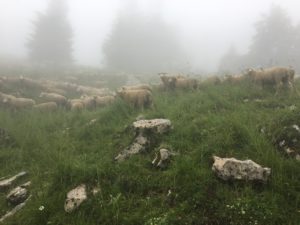
The cafe was full of people like me, waiting for the next train. In Haut-de-Caux, I stayed at the Coucou hotel. Charming location, confused reception. They gave me a room with a beautiful view of our beloved Lake Geneva and my heart swelled at the sight, telling me I had pretty much come home.
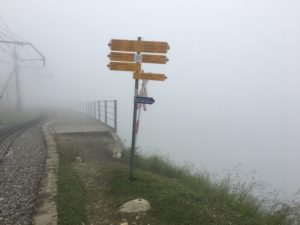
Day 8 Haut-de-Caux- Montreux
The next day would be easy, walking down to Montreux. The way was very civilized, cutting through numerous towns. Although I did come across a restaurant dedicated to goat enthusiasts, I think. I took a slightly longer way down, around the Gorges du Chauderon. It was beautiful, a stark contrast to scraggly mountain tops, lush and full of ferns growing sideways out of rock walls covered in moss and vines. But entering Montreux prompted a sigh. It’s a ritzy town, the kind where you see fancy sports cars driving slow. It’s fine. But it was a shock to the system. I walked along the promenade, where a pop song full of make-you-blush lyrics was blaring from a hotel terrace. It felt like an assault. I sped past the strolling families to Freddy Mercury’s statue to get a picture before reaching the Via Alpina’s starting point, even if I, you know, walked a different path.